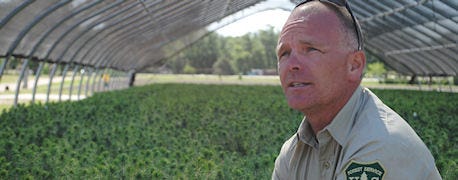
With the Eastern red cedar forest growing rapidly across Nebraska, choking out prime grazing land and pushing out native hardwood trees, the cedar tree is considered by many as a weed when it isn't planted in a windbreak. However, this native tree has long been considered one of the best for conservation plantings, because of its value to wildlife, its toughness and survivability.
While Bessey Nursery at the Nebraska National Forest near Halsey continues to raise and sell Eastern red cedar trees by the tens of thousands for conservation plantings, nursery manager, Richard Gilbert has been studying alternative species that could replace red cedar as a main species for conservation plantings.

Richard Gilbert has been testing different tree species as a substitute for red cedars.
"Bessey has been testing many different species as a substitute for red cedar," Gilbert says. "The big issue you have is that if you find that replacement plant, you are just replacing one weed with another."
Suitable replacement trees exist now, including Ponderosa, Austrian, jack and red pines in certain locations, Gilbert says.
"They do not have as good of survival rate as red cedar and are not as tough, but they also do not spread," he says. "Landowners need to work on management of red cedar," he explains. "Since man no longer allows fire to run across the land, red cedar can spread as fast as possible. Keep the pasture and prairie clear of red cedars, which also protects prairie habitat." He suggests controlling cedars when they are small, because they are easier to cut then, than when they are 20 feet tall.
Some research is being done elsewhere on asexual reproduction of a male Eastern red cedar. "We have tried for many years at Bessey, with little success," Gilbert says. "Tissue culture is another option, however, it is going to take time and money" to be successful.
You can learn more about Bessey Nursery and conservation tree plantings in Nebraska by reading an upcoming print article in Nebraska Farmer on the historic tree nursery at Halsey.
About the Author(s)
You May Also Like






